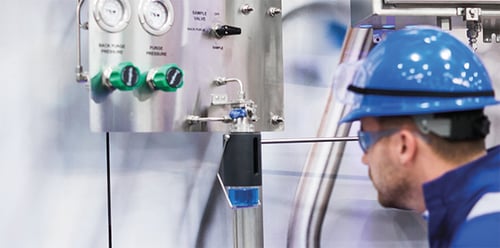Share this
How to Make Closed Loop Sample Extraction Simpler
by Morgan Zealear on 1/19/21 8:45 AM

Closed loop sample extraction can be simple—but not always. Bay Area refineries that run on heavier, more viscous crude oils know this all too well. They may incur sampling challenges not just for the crude oil itself, but downstream as well. This is especially true for more complex and modern refineries that may have more than one vacuum tower and handle a variety of heavy gas oil products.
Accurate sampling is more important than ever as access to heavy crude stocks from around the world—and more layers of governing authorities enforce environmental and safety regulations—are constantly changing and causing refineries to tweak their operations.
Some heavy crudes and asphalts require heated storage to remain pumpable. Inside the refining processes, there are many heavy gas oils such as vacuum tower bottoms that may need to be kept above 500°F to remain in a liquid state. Sampling these processes can be intimidating, but it can be done safely and accurately with the guidance of a vendor who has proven experience in designing sampling systems. With expert design and assembly services, it’s possible to simplify closed loop sample extraction and manage associated operator safety issues.
Common Problems Associated with Closed Loop Sampling
To ensure a reliable and safe system, Bay Area refineries need a closed loop sample system with good flow. Unfortunately, that isn’t always the case if the sample fluid is heavy oil or crude, vacuum tower bottoms, or asphalt, as the outlet can get plugged with hot and viscous streams that cool too much. Below we will discuss some common problems associated with sampling these fluids and potential solutions to expect from your sample station vendor to ensure your facility gets the samples it needs.
Problem:
Accurately sampling heavy gas oil or other products that will gel or solidify if cooled
Solution:
The closed loop sample system must maintain good flow. That often means wider piping or tubing and higher flow rates. Why both? The higher flow rate will keep the system hot by bringing fresh, hot liquid through it. Larger diameter tubing generally means solids are less likely to become lodged vs. longer time until failure.
The tubing must be insulated and also heat traced or steam traced. Heat tracing is typically preferred for hotter systems with a higher risk of solidification. Heat tracing can be installed with greater density than steam tracing and its operation controlled and monitored automatically if desired.
Problem:
Keeping the sample valve from plugging
Solution: Use inline or “no dead space” valves. These specialty sample valves are compact and integral to the closed loop sample flow line. This gives you an immediate accurate sample with no dead leg time. They are also compact and therefore easier to keep insulated and hot with heat tracing. Inline sample valves are essential to a working sample system, but alone are not enough. Inline sample valves should always be insulated, and heat traced.
Problem:
Safely sampling heavy gas oil or other products
Solution:
Hot fluid samples should always be taken in an enclosure. This assures the operator is protected from any spillage, splashing, or overfilling. This sampling enclosure can also have an air educator if needed to remove dangerous fumes. Once sampling is complete, then the operator can open the enclosure, and use appropriate handling methods for a very hot sample.
Problem:
Partially plugged closed loop or obstruction downstream of the sample valve
Solution:
Extra steam ports for flushing may be appropriate to add heat and flow to melt problems. (Note: extra steam may not be appropriate for some services.) Additionally, review the entire closed loop system insulation and heat tracing. Electric heat tracing is always preferable to steam tracing for better contact to the pipe, controllability, and reliability.
A properly designed sample system includes ports for steam or flushing oils to clean out the last sample line. An in-line sample valve won’t plug, but the tubing from it to the sample can still plug. These flush fluids may need to be collected. As sample system complexity increases, you need a sample system vendor that can be onsite and work with your operations teams and procedure writers to implement a safe, effective, and reliable system.
Make Closed Loop Sample Extraction Simpler with Expert Guidance
Simplifying closed loop sample extraction, especially when dealing with hot heavy fluids, is often a daunting task. System design and components should facilitate sampling procedures that reduce any problems that jeopardize sample quality or threaten operator safety. A well-designed closed-loop sampling system enables a reliable process that safely captures a representative sample and preserves it until analyzed.
Swagelok Northern California has been meeting the fluid system component needs of refineries in the Bay Area for more than 50 years. We now offer standard and customized closed-loop sampling solutions for use in all types of plants and facilities. Our local, factory-certified experts will assess your requirements, taking into account time delay, phase change, and common sample system problems, then design and assemble a system to ensure sample quality and operator safety. Swagelok also offers hands-on training regarding the proper use and maintenance of sampling systems.
To find out more about how Swagelok Northern California can help you with all your closed loop sampling systems needs, no matter how simple or complex, contact our team today by calling 510-933-6200.
 Morgan Zealear | Product Engineer – Assembly Services
Morgan Zealear | Product Engineer – Assembly Services
Morgan holds a B.S. in Mechanical Engineering from the University of California at Santa Barbara. He is certified in Section IX, Grab Sample Panel Configuration, and Mechanical Efficiency Program Specification (API 682). He is also well-versed in B31.3 Process Piping Code. Before joining Swagelok Northern California, he was a Manufacturing Engineer at Sierra Instruments, primarily focused on capillary thermal meters for the semiconductor industry (ASML).
Share this
- Archive (465)
- Assembly Services (207)
- About (100)
- Seal Support Systems (96)
- Best Practices (88)
- Training Services (74)
- Fittings (51)
- Semiconductor Applications (49)
- Hoses and Flexible Tubing (47)
- Regulators (44)
- Tubing (42)
- Grab Sampling Systems (32)
- Sampling Systems (32)
- Gas Systems (30)
- Services (30)
- Downloads (29)
- Valves (24)
- Application Support (18)
- Orbital Welding (17)
- Case Studies (13)
- Steam Systems (13)
- Frequently Asked Questions (12)
- Tools (12)
- Measurement Devices (7)
- Subsystems (6)
- Thermal Management (6)
- September 2023 (1)
- August 2023 (2)
- June 2023 (1)
- March 2023 (3)
- February 2023 (3)
- January 2023 (4)
- December 2022 (4)
- November 2022 (4)
- October 2022 (4)
- September 2022 (1)
- August 2022 (3)
- July 2022 (2)
- June 2022 (4)
- May 2022 (1)
- April 2022 (2)
- March 2022 (1)
- February 2022 (2)
- January 2022 (3)
- December 2021 (1)
- November 2021 (6)
- October 2021 (6)
- September 2021 (8)
- August 2021 (4)
- July 2021 (3)
- June 2021 (6)
- May 2021 (6)
- April 2021 (7)
- March 2021 (5)
- February 2021 (4)
- January 2021 (6)
- December 2020 (5)
- November 2020 (6)
- October 2020 (6)
- September 2020 (8)
- August 2020 (7)
- July 2020 (8)
- June 2020 (8)
- May 2020 (6)
- April 2020 (9)
- March 2020 (7)
- February 2020 (10)
- January 2020 (21)
- December 2019 (23)
- November 2019 (21)
- October 2019 (22)
- September 2019 (21)
- August 2019 (22)
- July 2019 (23)
- June 2019 (20)
- May 2019 (23)
- April 2019 (22)
- March 2019 (21)
- February 2019 (20)
- January 2019 (21)
- December 2018 (14)
- November 2018 (19)
- October 2018 (23)
- September 2018 (17)
- August 2018 (29)
- July 2018 (11)
- June 2018 (6)
- May 2018 (5)
- April 2018 (4)
- March 2018 (5)
- February 2018 (3)
- January 2018 (3)
- December 2017 (2)
- November 2017 (4)
- October 2017 (3)
- September 2017 (2)
- August 2017 (6)
- July 2017 (4)
- June 2017 (4)
- May 2017 (4)
- April 2017 (3)
- March 2017 (4)
- February 2017 (3)
- January 2017 (3)
- December 2016 (3)
- November 2016 (3)
- October 2016 (3)
- September 2016 (5)
- August 2016 (5)
- July 2016 (4)
- June 2016 (5)
- May 2016 (3)
- April 2016 (4)
- March 2016 (5)
- February 2016 (11)
- January 2016 (1)
- December 2015 (3)
- November 2015 (4)
- October 2015 (3)
- September 2015 (4)
- August 2015 (4)
- July 2015 (8)
- June 2015 (5)
- May 2015 (3)
- April 2015 (4)
- March 2015 (4)
- February 2015 (3)
- January 2015 (4)
- December 2014 (2)
- November 2014 (3)
- October 2014 (4)
- September 2014 (4)
- August 2014 (4)
- July 2014 (5)
- June 2014 (4)
- May 2014 (4)
- April 2014 (5)
- March 2014 (4)
- February 2014 (3)
- January 2014 (4)
- December 2013 (5)
- November 2013 (3)
- October 2013 (4)
- September 2013 (3)
- August 2013 (5)
- July 2013 (5)
- June 2013 (5)
- May 2013 (3)
- April 2013 (6)
- March 2013 (4)
- February 2013 (4)
- January 2013 (8)
- December 2012 (4)
- November 2012 (6)
- October 2012 (6)
- September 2012 (4)
- August 2012 (4)
- July 2012 (4)
- June 2012 (4)

.webp?width=210&height=70&name=StickyLogo%20(5).webp)